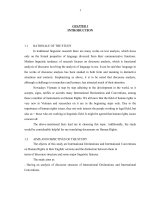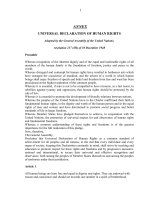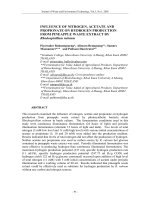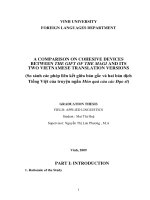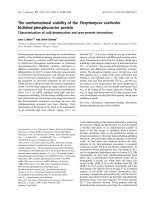Meat production performances of cay cum chickens on rations with different levels of metabolizable energy and crude protein with probiotics
Bạn đang xem bản rút gọn của tài liệu. Xem và tải ngay bản đầy đủ của tài liệu tại đây (1.64 MB, 79 trang )
..
MEAT PRODUCTION PERFORMANCES OF CAY CUM CHICKENS IN
RATIONS WITH DIFFERENT LEVELS OF METABOLIZABLE
ENERGY AND CRUDE PROTEIN WITH PROBIOTICS
A Thesis
Presented to the Faculty of the
Graduate Studies and Applied Research
College of Agriculture
Laguna State Polytechnic University
Siniloan, Laguna
In Partial Fulfillment
of the Requirements for the Degree
Master of Science in Agriculture
Major in Animal Science
DIEN PHAM VAN
June 2019
i
VISION, MISSION, QUALITY POLICY, GOALS AND OBJECTIVES
Vision
The Laguna State Polytechnic University is a center for sustainable
development, initiations transforming lives and communities.
Mission
LSPU
provides
quality
education
through
responsive
instruction,
distinctive research, sustainable extension and production services for improved
quality of life towards nation-building.
Quality Policy
We, at LSPU are committed with continual improvement to provide quality,
efficient services to the university stakeholder’s highest level of satisfaction
through a dynamic and excellent management system imbued with utmost
integrity, professionalism and innovation.
Goals
1. Graduate Education is at the apex of the educational system. In the field of
education, professionals who aim to continued improvement of teaching and
learning in the classrooms, delivery of student services, and management of
educational programs
2. Graduate education also one of the most effective means of developing
capabilities related to ding research that will improve educational theory and
practice in many aspects of educational process
ii
3. Establish a graduate school that is expected to be a molder of the Filipino
minds and laboratory for the study of social, technological, economic
problems besetting our people and the country today
Objectives
1. To acquire advanced professional training and technological skills necessary
for one in maximizing his her teaching competencies and managerial ability
in his/her field of specialization.
2. To produce quality graduates needed in the field of work.
3. To develop and elevate one's aesthetic and personal ideals particularly in his
fields of specialization, and
4. To gain advanced knowledge and skills in conducting various kinds of
research in one's field of study.
iii
Republic of the Philippines
Laguna State Polytechnic University
Province of Laguna
COLLEGE OF AGRICULTURE
APPROVAL SHEET
This research entitled “MEAT PRODUCTION PERFORMANCES OF
CAY CUM CHICKENS IN RATIONS CONTAINING DIFFERENT LEVELS OF
METABOLIZABLE ENERGY AND CRUDE PROTEIN WITH PROBIOTICS”
prepared and submitted by PHAM VAN DIEN in partial fulfillment of the
requirements for the degree of Master of Science in Agriculture Major in
Animal Science has been examined and is hereby recommended for approval.
ROBERT C. AGATEP, Ph.D.
Adviser
________________________________________________________________
PANEL OF EXAMINERS
Approved by the COMMITTEE ON ORAL EXAMINATION with a grade of
______.
NESTOR M. DE VERA, Ph.D.
Chairman
LOLITA L. BEATO, Ph.D.
Member
ROBERT C. AGATEP, Ph.D.
Member
LOLITA D. VIYAR, Ph.D.
Member
FLORENCIO G. REBERTA, JR., MRD
Member
Accepted in partial fulfillment of the requirements for the degree of Master
of Science in Agriculture, Major in Animal Science.
LOLITA L. BEATO, Ph.D.
Dean
Research Contribution No.:______________
ISABELITA DOMINGO, RPChE
Chairperson, Research
MA. GRACIELA C. PRADILLADA, R.G.C.
Registrar III
iv
DISCLAIMER
The Laguna State Polytechnic University-Siniloan Campus nor the
researcher does not constitute to the promotion of the brands mentioned and/or
the demotion of the other brands not mentioned herein.
v
DEDICATION
This priceless Master’s Thesis is sincerely and lovingly dedicated
to my family PHAM VAN NGHIA, NGO THI BICH,
NGUYEN VAN BIEN, NGUYEN THI PHUONG.
vi
ACKNOWLEDGMENT
This Master Thesis would not have been possible without the guidance
and help of several individuals who contributed and extended their valuable
assistance in the preparation and completion of this study.
Laguna State Polytechnic University, his alma mater, for the knowledge,
skills, and values gained towards the fulfillment of his dream;
Dr. Robert C. Agatep, Thesis Adviser and Statistician, for the never ending
encouragement, support, shared knowledge and ideas for the completion of this
study;
Dr. Nestor M. De Vera, the University President, for the inspiration and
being a living example of a successful manager and leader; and for being the
Chairman of the Oral Defense Panel, for his wise advises and comments to
improve this study.
Dr. Lolita L. Beato, his Adviser and Dean of College of Agriculture, for the
comments, suggestions and guidance to finish this work and for the unbounded
encouragement and steadfast support in the conduct of this study;
Dr. Lolita D. Viyar, Technical Editor, for the meaningful pieces of advice
she shared and for still believing the author through his thick and thins.
Mr Florencio G.Reberta, JR the Coordinator graduate program, for sharing
his expertise and genuine apprehension for the improvement of His manuscript;
vii
LSPU-security guards, for lending the author a walky-talky, and for always
securing the authors welfare.
Registrar Office family, Ma’am Bing, Ma’am Josie, Ma’am Grace, Ma’am
Jai, Ma’am Julie, Ma’am Vangie, Sir Mario, and Sir McNe for the prayers and
motivation.
Grateful appreciation and thanks is also extended to Mrs. BUI THI THOM
for the financial support they have rendered for this study to materialize.
The Author also expresses his heartfelt and sincerest gratitude to his
tender loving parents, Mr. PHAM VAN NGHIA and Mrs. NGO THI BICH for
unending encouragement, unconditional love and care, guidance and support.
His family supported him morally, financially, emotionally and spiritually. The
author owes this success to you.
His compassionate siblings PHAM THI HUE, PHAM THI CHUYEN, for
their love, kindness, and help.
viii
ABSTRACT
PHAM VAN DIEN, Laguna State Polytechnic University Siniloan, Laguna November
2018, “MEAT PRODUCTION PERFORMANCES OF CAY CUM CHICKENS IN
RATIONS WITH DIFFERENT LEVELS OF METABOLIZABLE ENERGY AND
CRUDE PROTEIN WITH PROBIOTICS" . Adviser: Dr. Robert C Agatep.
A 2x3 factorial experiment in Split-Plot Design in a Randomized Complete
Block Design was conducted in under to determine the meat production
performances of Lac Thuy chickens in rations containing different levels of
metabolizable energy and crude protein with and without probiotics.
Results show that significant interaction between the effects of the
inclusion of probiotics and the different levels of metabolizable energy and crude
protein in the ration were detected on the final bodyweight, feed consumption,
feed conversion efficiency, gross profit margin of production and protein
efficiency ratio of 90 days old Cay Cum chickens.
The best effects in terms of the above-mentioned parameters were
observed from the ration with probiotics and containing 2904 kcal ME/kg with
22% CP at 1 to 45 days of age and 2945 kcal ME/kg with 19% CP at 46 to 90
days of age.
No significant interaction but main effect of the inclusion of probiotics in
the feeds and the different levels of ME and CP in the ration were detected on
the energy efficiency ratio of the experimental chickens. The energy efficiency
ratio is significantly higher among the chickens given with the feeds containing
probiotics, irrespective of the ME and CP contents of the ration. Likewise,
irrespective of the inclusion or non-inclusion of probiotics in the feeds, the best
energy efficiency ratio was observed among the chickens fed with the ration
ix
containing 2904 kcal ME/kg with 22% CP at 1 to 45 days old and 2945 kcal
ME/kg with 19% CP at 46 to 90 days of age.
The dressing percentage, cut-up parts yield and carcass characteristics of
the 90-day old Cay Cum chickens were apparently not affected by the treatments
applied. Nevertheless, the carcasses from the experimental chickens have reached
acceptable levels for chicken carcass characteristics in terms of these parameters.
Conclusions
Based on the findings stated above, the following conclusions were made:
1. Significant interaction between the effects of the inclusion of probiotics
and the different levels of metabolizable energy and crude protein in the ration
were detected on the final bodyweight, feed consumption, feed conversion
efficiency, gross profit margin of production and protein efficiency ratio of 90 days
old Cay Cum chickens. Therefore, hypothesis is not sustained.
2. No significant interaction but main effects of the inclusion of probiotics
in the feeds and the different levels of ME and CP in the ration were detected on
the energy efficiency ratio of the experimental chickens. Therefore, hypothesis is
sustained.
3. The dressing percentage, cut-up part yield and carcass characteristics
of the 90 days of age Cay Cum chicken were apparently not affected by the
treatments applied. Therefore, hypothesis is sustained.
Recommendations
Based on the findings and conclusions made, the following are
recommended:
x
1. For optimum meat production performance and profitability, Cay Cum
chickens can be fed with ration with probiotics (Bacillus and Lactobacillus) and
containing 2904 kcal ME/kg with 22% CP at 1 to 45 days old and 2945 kcal
ME/kg with 19% CP at 46 to 90 days of age for optimum meat production and
performance.
2. The utilization of locally-available feed materials in the formulation of
feeds for the Cay Cum chicken and other native chicken breeds can be
explored in future research.
3. Evaluation of the metabolizable energy and crude protein requirements
of other native chicken breeds at different types and/or stages of production, and
different seasons of the year can be done in order to establish the optimum
requirement of these genotypes in these conditions.
xi
TABLE OF CONTENTS
Title
Page
TITLE PAGE
I
VISION, MISSION, QUALITY POLICY, GOALS AND OBJECTIVES
ii
SPECIFIC OBJECTIVES
iii
APPROVAL SHEET
iv
DISCLAIMER
v
DEDICATION
vi
ACKNOWLEDGEMENT
vii
ABSTRACT
ix
TABLE OF CONTENTS
xii
LIST OF TABLES
xv
LIST OF APPENDIX TABLES
xvi
LIST OF APPENDIX PLATES
xvii
Chapter
1 THE PROBLEM AND ITS BACKGROUD
1
Introduction
1
Background of the Study
4
Theoretical Framework of the Study
6
Conceptual Framework of the Study
7
Statement of the Problem
9
Hypothesis
9
Significant of the Study
10
xii
2
3
4
Scope and Limitations of the Study
10
Definition of Terms
11
REVIEW OF RELATED LITERATURE AND STUDIES
13
Related Literature
13
Related Studies
16
RESEARCH METHODOLOGY
21
Research Design
21
Materials
22
Sampling Techniques
23
Special Techniques and Procedures
23
Preparation and Disinfection of the Poultry House
23
Procurement of Experimental Materials and Stock
24
Brooding Management
25
Feeding Management
26
Water Management
26
Health and Sanitation
27
Data Gathering Procedure
27
Data Processing and Statistical Analysis
29
PRESENTATION ANALYSIS AND INTERPRETATION OF DATA
30
Final Body Weight of the Chicken, in grams
30
Total Feed Consumption of the Chickens, in grams
31
Feed Conversion Ratio (FCR) of the Chickens
32
Gross Profit Margin in Raising the Chickens, in percent
34
xiii
5
Energy efficiency ratio
35
Protein efficiency ratio
36
Dressing percentage and cut-up part yield
37
Carcass characteristic of chickens
39
SUMMARY, CONCLUSIONS, AND RECOMMENDATIONS
42
Summary
42
Conclusion
44
Recommendation
45
BIBLIOGRAPHIC
47
APPENDICES
52
Appendix of Table
53
Appendix of Plate
55
CURRICULUM VITAE
61
xiv
LIST OF TABLES
Table
Title
Page
1
Composition and nutrient contents
25
2
Average Final Body Weight of the Chicken, in grams
31
3
Average Total Feed Consumption of Chickens
32
4
Average Feed Conversion Efficiency of Chickens
33
5
Gross Profit Margin in Raising the Chickens
34
6
Average Energy efficiency ratio
36
7
Average Protein efficiency ratio
37
8
Average cut-up part yield of the chickens
38
9
Carcass color of experimental chicken meat
39
10
Tenderness of experimental chicken meat
40
11
Water-holding capacity of experimental chicken meat
41
xv
LIST OF APPENDIX TABLES
Table
1
Title
Gantt chart
Page
54
xvi
LIST OF PLATES
Plate
Page
1
Setting up the experimental cages
56
2
Probiotic
56
3
Preparation/mixing of the ration
57
4
Day-old chicks during brooding
57
5
Cay Cum chicken at 4 weeks of old
58
6
Cay Cum chicken at 9 weeks of old
58
7
Carcass of slaughtered chicken
59
8
Sampling of carcass for cut-up parts yield determination
59
9
Breast and leg muscles of Cay Cum chickens
60
10
Meat Sample
60
xvii
1
Chapter 1
PROBLEM AND ITS BACKGROUD
Introduction
Vietnam is an agricultural country with more than 80% of the population lives in
rural areas, and 70% of the social forces participate in agricultural production. In
agricultural production, there are two major production sectors, cultivation and livestock.
The livestock sector in Vietnam has a long history. With the attention of the
government, the poultry industry is growing and bringing economic efficiency. Not
only providing food with high economic value and meeting the food demand for
society but it also bring significant source of income for livestock farmers. Besides,
it also provides a large amount of fertilizer for the cultivation. Objects of the poultry
industry are: chicken, duck and goose. Chicken as being raised most popular
(Vivien, 2014).
In the past few decades, in order to meet the demand for food for the society,
Vietnam has imported many breeds of high-yielding industrial chickens. The number
of farms as well as the scale of livestock farming have increased steadily over the
years. As a result, the local production of native or indigenous chicken breeds have
shrunked, and some varieties have become extinct (Nguyen Van Duc, 2016).
At present, with the economic improvement experienced in the country the
market demand for food from the local cattle and poultry breeds of delicious quality
had increased. In particular, indigenous chickens have become a specialty because
of its meat quality and its attractive flavor. The local breeds are more adapted to the
climatic conditions in Vietnam, and likewise, have higher disease resistance.
2
Furthermore, local chicken breeds possess very rare genetic resources that
can be used for the development of highly efficient hybrid chickens. They also
offer genetic materials for the creation of poultry breeds under the Vietnamese
brand name in the future.
Cay Cum chicken is a strange chicken, with various feather colors such as
brown gray, white with black stripes, lilac blossom, brownish crest, yellow legs
and special tail appearance because the rump does not protrude. They can attain
an average bodyweight of only 1.5 to 2.5 kilograms at maturity. Their incubation
rate is similar to that of other local breeds and their meat is firm and delicious but
less known. This breed is abundantly found in the provinces of Ha Giang and Cao
Bang (Nguyen Thi Thuy Linh, 2016).
In order to achieve high economic efficiency in poultry raising, it is necessary
to choose a complete feed with appropriate nutrient content, as feed accounts for
nearly 70% of the total cost of production. Nutritional balances in the ration should
be evaluated to meet the needs of poultry in order to increase product yield and
increase feed efficiency. Research on the nutrition, specifically in the establishment
of the appropriate nutrient levels in the rations of poultry is one of the topics that is
being studied continuously. Studies on food and animal nutrition have a common
goal, that is, to raise the production value of livestock and to lower the cost of
production (Dam Thi Thao, 2015).
Energy and protein are very important nutrients for chicken. Energy is
required for proper body functioning and protein is an essential constituent of all
tissues of the animal body. Proteins have major effects on the growth performance
3
of the bird and is considered as the most expensive nutrient in poultry diet. It is a
widely accepted principle in poultry nutrition that dietary energy and essential
nutrients must be considered as an entity. To ensure maximum utilization of
energy, right proportion of protein and the other nutrients are necessary for the
optimum growth of the birds (Sadegh, 2011).
The growth and production of chicken meat is affected by the exchange of
energy and crude protein in the diet. Furthermore, the metabilizable energy (ME)
intake may be a limiting factor for poultry growth in most environmental conditions.
Leeson and Summer (1989) suggests that pullet growth is most sensitive to protein
and amino acids in the diet, whereas ME in the fed is needed when poultry
progressed to adulthood. Studies show that ME and crude protein (CP)have
significant effects on growth, meat production, reproduction and economic efficiency
in chickens production (Hoang Van Loc, 1999; Nguyen Duy Hoan, 1999). In addition,
the ability to digest, absorb and assimilate protein is largely dependent on ME levels
in the diet (Bui Duc Lung, 2001). Therefore, ME and CP are closely related to a
certain constant in the diet at each stage of development and production of poultry.
At the same time, ME and CP also affect the growth and development of Cay Cum
chickens during growth stages, but studies on this influence are not much. Besides,
farmers usually leave this type of chicken to eat freely without knowing the level of
ME and the rate of CP suitable for them. In other words,
there is no feeding
standard yet for the Cay Cum chicken. Therefore, this study aim to determine the
optimum ME and CP levels in the diet for the growth of Cay Cum chickens.
4
With the growing concern about the emergence of antimicrobial resistance,
the use of antibiotic therapy is being warned. Consumer pressure coupled with the
fact that certain bacteria have adopted the ability to be impermeable to antibiotic
treatment, the poultry industry has begun researching alternative ways to treat
bacterial infection. One such way is the use of direct-fed microbial probiotics (Richard
and Yitzhak, 2014). Probiotics are live bacteria that are given to a host to enhance the
gastrointestinal health and micro flora within the gut. Direct-fed microbials are currently
being used within the poultry industry and are considered production enhancers. They
are given to broiler flocks to enhance growth performance as well as to convey
beneficial properties to the micro flora environment within the gut. Moreover, directfed microbials are thought to be able to inhibit the growth of pathogenic bacteria.
There are many reports concerning the effect of using probiotics including
Lactobacillus, Bifidobacterium, Bacillus, Streptococcus, Pediococcus, Enterococcus,
and yeast such as Saccharomyces the scientific have cerevisiae on chickens (Endo
and Nakano, 1999; Mountzouris et al., 2007). However, there is currently no study
evaluating the effect of Bacillus and Lactobacillus on Cay Cum chickens. From the
aforementioned reasons, this research was conducted.
Background of the Study
It is of interest to determine whether the poor growth performance resulting
from low-CP diets can be overcomes by maintaining a constant ME:CP ratio. It is
now well documented that dietary composition and the ratios between the
macronutrients have a major effect on performance and body composition of
chickens (Buyse et al., 1992; Collin et al., 2003). In general, diets with high energy
5
protein ratios promote energy retention as fat; however, little is known about the use
of low-CP diets with a constant energy: protein ratio. Although much work has been
conducted on reducing the CP and ME contents of native chickens diets in opentype houses using local nutrient requirements for subtropical region, very little
experimentation has been done in environmentally controlled houses using nutrient
recommendations for native chicken. Therefore, the present study was planned to
determine whether a low-CP diet with a constant ME:CP ratio can support growth
performance and carcass characteristics of native chickens equal to that of a high
CP diet from 1 to 90 days of age.
On the other hand, some of the most important factors affecting the quality
of poultry meat are body weight and age at slaughter, They do not only determine
the organoleptic attributes of meat, but also have an effect on its technological
properties. In the modern Intensive poultry production, age at slaughter depends
on whether birds attain the desired body weight, and for many years the duration of
rearing has tended to decrease. This course of action is dictated by the desire to
improve the economic results of rearing meat chickens, which should be
slaughtered immediately after the birds reach the maximum rate of weight gain.
The slow growing lines of chickens from foreign producers are sometimes
used in alternative poultry meat production systems. Native breeds of chickens can be
used for this purpose (Poltowicz et al., 2005), but the amount of meat obtained from
them is small due to their low bodyweight and considerably lower breast meat yield
compared to broilers. At the same time, this meat is characterized by valuable culinary
and dietetic qualities, including the high protein content and the low fat content.
6
Due to their popularity and usability it is so important to improve the meat
performance, economics of production and the meat quality of the Cay Cum
chickens in Vietnam. As far as available literature is concerned, no research work
has yet been conducted to study the effects of probiotics meals at different ages
and bodyweights on the meat performance and quality of these chickens.
The factors affecting the growth of an animal include inheritance, genetic
imbalances, sex, and plane of nutrition, health condition, and favorable
environment. The production performance of domesticated animals is being affected
by the degree to which its genetic potential is being expressed. Environment
includes all surrounding factors that affect the animal such as management,
nutrition, and disease. It also includes climatic factors such as temperature, humidity
and ventilation, which must be properly managed, or modified if practical, for efficient
production performance (Cunningham, 2011).
Theoretical Framework of the Study
Production performance of the native chicken could be improved by
employment of effective breeding strategies and with provision of suitable
environment for the new genetic make-up to prosper.
Viet Nam recommends for broiler production as cited by Thien (2002) stated
that the potential of chick is determined by genetics component. Its actual
performance, however, depends upon the feeding, care, and management it
receives from the caretaker. The chicks could express their genetic potential only if
proper management and nutrition are provided to them
7
The performance and production of domesticated animal affect the degree to
which its genetic potential is expressed. Environment includes all surrounding factors
that affect the animal such as management, nutrition, and disease. It also includes
climatic factor such as temperature, humidity and ventilation, which must be properly
managed, or modified if practical, for efficient practical performance (Acker and
Cunningham, 2001).
In this research activity, the effect different of levels of metabolizable energy
and crude protein with probiotic in the ration on the performance of Cay Cum
chicken was observed under complete confinement litter floor rearing system.
Conceptual Framework of the Study
Figure 1 shows the conceptual model of the study. The box in the left
contains the independent variables, which include the rations with or without
probiotic; and the different levels of crude protein and metabolizable energy. The
ME:CP ratios were maintained at 132 at 1-45 days of age and 155 at 46-90 days of
age. Two experimental diets were formulated to have 3 levels of CP and ME,
respectively, in each phase: 23, 22, and 21% CP with 3,036, 2,904, and 2,772 kcal/kg
in the first period; 20, 19, and 18% CP with 3,100, 2,945, and 2790 kcal/kg in the
second period. The box in the right houses the dependent variables which include
performance of Cay Cum chicken in terms of body weight, feed consumption, feed
conversion efficiency, gross profit margin, dressing percentage and cut-up part yield,
energy efficiency ratio, protein efficiency ratio, and carcass characteristic. The arrow
connecting the two boxes connotes a cause and effect relationship.
8
Independent Variables
Main-plot factor- Probiotics
A1. Rations with probiotics
Dependent Variables
Performance of 90 days old
Cay Cum chickens
A2. Rations without probiotics
1. Body weight
Sub-plot
Factor-
Metabolizable
2. Feed consumption
energy and Crude protein levels
3. Feed conversion efficiency
B1. 3036kcal ME/kg and 23% CP
4. Gross profit margin
at 1 to 45 days of age
5. Dressing percentage
. 3100 kcal ME/kg and 20% CP
6. Energy efficiency ratio
at 46 to 90 days of age
7. Protein efficiency ratio
B2. 2904 kcal ME/kg and 22% CP
8. Cut-up part yield
at 1 to 45 days of age
9. Carcass characteristics
. 2945 kcal ME/kg and 19% CP
9.1. Tenderness
at 46 to 90 days of age
9.2. Water-holding capacity
B3. 2772 kcal ME/kg and 21% CP
9.3. Color
at 1 to 45 days of age
. 2790 kcal ME/kg and 18% CP
at 46 to 90 days of age
Figure1. Conceptual framework showing the interplay of independent and dependent
variables of this study

